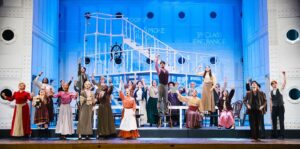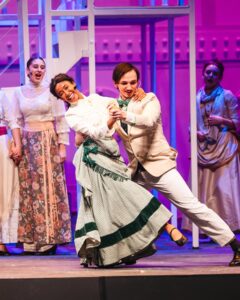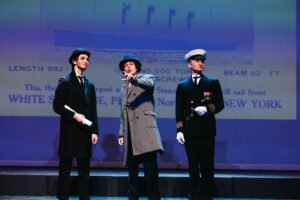ON THE TOWN WITH CHIP DEFFAA : CATCHING “TITANIC” AT THE FRANK SINATRA SCHOOL OF THE ARTS
I’ve never seen any student production—at the high school or college level—achieve a more glorious ensemble sound than the ensemble sound produced by the students of the Sinatra School in their finely honed production of “Titanic.”

by Chip Deffaa, Editor-at-Large
[avatar user=”Chip DeFFaa” size=”96″ align=”left”] Chip DeFFaa, Editor-at-Large[/avatar]
I went to see “Titanic” at the Frank Sinatra School of the Arts with no intention of writing anything about it. I was going simply for my own enjoyment. “Titanic” is a rarely revived musical with a gorgeous score. The students at the Sinatra School always do good work, and this production would showcase students from all grades in the school. (The Sinatra School is —along with Fiorello H. LaGuardia High School and the Professional Performing Arts High School—one of New York’s three top high schools for students interested in the performing arts.) I particularly wanted to see the work of some talented seniors (like Logan Spaleta, Imogen Williams, Andres Mejia, Daniel Stowe) whose growth as performers I’ve witnessed over the years—several of whom I’ve suggested in print, here and elsewhere, give me hope for the future. In a lifetime of theater-going, I’ve seen a number of youths make the jump from being impressive student performers to becoming successful working professionals.
So, I went expecting to see a pretty good production. But the production, directed by Dr. Jamie Cacciola-Price, was so terrifically well done, I need to write something about it.
I’ve never seen any student production—at the high school or college level—achieve a more glorious ensemble sound than the ensemble sound produced by the students of the Sinatra School in their finely honed production of “Titanic.” The sheer, shimmering tonal beauty, the remarkable cohesiveness of the students on the full–company numbers—like “Godspeed Titanic.” “To the Lifeboats,” and the finale—was something to marvel at. They had 24 student musicians in their pit orchestra, and 39 student actors singing on stage, all under the direction of Heidi Best, a veteran faculty member whose work I’ve appreciated in various shows. The school always does good work. But this really was something special.
The students had me hooked, just from the big ensemble numbers. (I wonder–did anyone think to invite Maury Yeston, the composer of this musical? I’m sure he would have loved this.) I wish I had space here to name every student in the orchestra and every student on the stage. (But that would be more than 60 students; it’s just not possible.) However, the program indicates that Logan Spaleta and Tsehai Marson were “Vocal Captains”—a position that doesn’t even exist at most schools, although they’d be wise to have such a position–and they deserve recognition for their contributions to the success of the big numbers. Yeston wrote a remarkable score (brilliantly orchestrated by Jonathan Tunick), with a soaring, symphonic kind of sweep and grandeur. And the full–company numbers, as executed by the students at the Sinatra School, provided some of the most rewarding moments I’ve experienced in any theater in recent years.
I’ve seen excellent ensemble work at some other great schoolsover the years. I remember fondly the brilliant production of Sondheim’s “Into the Woods” (with music direction by Marianna Vagnini-Dadamo) at the Waterbury, CT, Arts Magnet School (the star of which, since graduation, has become a regular member of my recording family). And the students at LaGuardia particularly impressed me with their work—as both singing actors and musicians—in their memorable productions of “Sweet Charity” (featuring a not-yet-famous Timothee Chalamet) and “Guys and Dolls” (starring a not-yet-famous Ansel Elgort, whom I noted in these pages was one of the three best student actors I’d ever seen in 20 years of watching LaGuardia shows). LaGuardia students shined, too, on their concert-style presentation of “Titanic” some years back, although it did not have the astonishing vocal cohesiveness of the Sinatra School’s version, which benefitted from an extraordinarily long rehearsal process.
The Sinatra School students have worked for seven long months on this production, investing an incredible 1,000 hours of rehearsal time. And it’s paid off. The students were just so “together.” While watching them, I was remembering how hard it was for me to keep just 10 singers together—breathing together, phrasing together, holding notes together—when we recorded the original cast albums for two of the musicals I’ve written, “The Seven Little Foys” and “Theater Boys.” And these well-routined Sinatra School students were making it all appear so natural, so effortless. And keeping the energy high throughout. No small feat!
There’s a polish and a sheen that can be achieved if you can put in enough rehearsal time. When I directed my show “George M. Cohan Tonight!” in New York, we rehearsed for three weeks. I was pretty happy with the results—I like working quickly–and we got rave reviews from The New York Times and every place else. But when the first Korean production of my show opened, they rehearsed for three solid months, not weeks, before opening–and I could see the difference. They took the time to perfect each transition, each movement, each gesture. The star—Korea’s number-one musical comedy star—was shown to his very best advantage. Extra hours of rehearsal time, if you can have them, do make a difference. In June, I’m looking forward to seeing a production of “Titanic” at New York City Center. Now, the City Center Encores presentations are generally extremely well-cast, drawing upon the best available Broadway performers. Any City Center Encores presentation—so rich with talent–is well worth seeing. But the City Center shows are—of necessity–mounted with the least possible amount of rehearsal time. It will be interesting to see if their ensemble sounds will be as well-blended and polished as those I heard at the Sinatra School.
Do the students at the Sinatra School realize how lucky they areto be part of a production like this? And what an extraordinary school they’re attending? (Do the parents realize it? Do the politicians and school-board members overseeing the public schools realize it?) The Sinatra School sets very high standards—which are not the norm at most public schools. (Right now I’m remembering a couple of ensemble singers casually talking to one another, and one was chewing gum, during an ensemble number at my niece’s school). But any industry professional witnessing this production of “Titanic” would be impressed.
 The Sinatra School students gave eight performances of “Titanic,” over a span of two weeks, in their state-of-the-art, 800-seat theater (named after Tony Bennett, who founded the school and generously provided financial support). And on Monday night, March 25th, 2024, they performed excerpts from their production on the stage of Broadway’s legendary Winter Garden Theater; they were one of five high school productions chosen by the Shubert Organization to be so honored in the Shubert’s tenth annual celebration of outstanding high-school theater. An honor well-deserved!
The Sinatra School students gave eight performances of “Titanic,” over a span of two weeks, in their state-of-the-art, 800-seat theater (named after Tony Bennett, who founded the school and generously provided financial support). And on Monday night, March 25th, 2024, they performed excerpts from their production on the stage of Broadway’s legendary Winter Garden Theater; they were one of five high school productions chosen by the Shubert Organization to be so honored in the Shubert’s tenth annual celebration of outstanding high-school theater. An honor well-deserved!
I’ve always enjoyed the shows and concerts I’ve seen at the Sinatra School (and at LaGuardia and at the Professional Performing Arts School). But different musicals allow different talents to be showcased. This was the first time I had a chance to fully realize what an exceptionally fine orchestra they have at the Sinatra School. When they did Jonathan Larson’s Pulitzer Prize-winning rock opera, “Rent,” two years ago, I was so impressed I called my friend Victoria Leacock Hoffman, who’d been Jonathan Larson’s girlfriend and first producer, to tell her it was one of the best productions of “Rent” (not counting the original New York production) I’d ever seen, and add that one of the stars, Logan Spaleta, was an artist to watch. But “Rent”featured only a small rock band, not a full orchestra. Theschool’s next big show, “Carrie” (with Imogen Williams and other terrific players) featured a bigger orchestra. But if the score of “Titanic” is like a sumptuous gourmet meal, the score of “Carrie” is more like tasty junk food. Neither “Rent” nor “Carrie” provided quite as great a showcase for the orchestral and vocal talents of the school as “Titanic.” (Someday, I’d love to see what the school could do with “Ragtime”—what a magnificent, epic, challenging musical that is!)
For “Titanic” I sat, as usual, as close to the stage as possible. I could see the musicians playing in the pit; had I not actually seen that they were students, I would have guessed that they were adult professionals. (And I’ve seen musicals at some private schools, like Oakwood in Poughkeepsie and Fieldston in the Bronx, where they hired top professional musicians to provide the music—which of course sounds great but doesn’t provide a learning experience for student musicians, the way the Sinatra School is doing.) And the Sinatra School is all about learning; the kids even built the set, which I liked a lot. And they had a turntable—a revolving stage—which added a lot.
* * *

I take young performers seriously. If you have a good eye, you can spot the potential early on. Broadway pros like Stephen Bogardus, Eric William Morris, and Tony Award-winner Santino Fontana—all of whom have made great recordings for me, singing on albums I’ve produced—first impressed me when they were just teens, many years ago. I saw their potential. And some of the young performers at all of these top high schools will go on to professional careers. But whether they decide to pursue professional careers or not, they’re doing very good work right now, and it brightened my month to see their work in “Titanic.”
In some ways, I actually liked the Sinatra School’s production of “Titanic” more than the original Broadway production. I’m not saying that the Sinatra School’s young actors were better than their Broadway counterparts; that would, generally speaking, be absurd. Broadway pros have the benefit of years of experience; teens are just getting started, and it takes time for talents to ripen. The original Broadway cast of “Titanic” included one strong, seasoned pro after another: Michael Cervaris, David Garrison, Victoria Clark, Brian D’Arcy James, and so on.
I was rooting for the original Broadway production of “Titanic” to succeed. (And I had friends in the cast.) But I thought the Broadway show was actually over-produced. The massive, enormously expensive set dominated the production, often over-shadowing the performers. Audience members left the theater talking about the set rather than the performers or the music.
The settings in the original Broadway production had, I felt, a weighty, ponderous, obtrusive feel. The scenery made the actors appear small. And a fortune was spent to have the whole set tilt as the ship began to sink into the ocean. But that massive set gave the show—for me—a kind of claustrophobic feel. The set seemed to be more important to the producers than the actors or the music. And the set actually hampered the director and the actors; it limited where actors could stand or where they could move. The actors were often hemmed in by the scenic design. And that gave the production a somewhat static feeling.
The Sinatra School’s set, with much more of an open, abstract feel, allowed the director to make better use of the space, and allowed him to put his players wherever it best served the story. The number “The Latest Rag,” joyously performed by the ship’s bandleader, Hartley (played by Andres Meijas), and company, felt absolutely magical. (I wish I could see and hear it again.) The whole stage burst into life! Meijas is a terrific singer—a much more appealing singer than Ted Sperling, who played the role of Hartley in the original Broadway production. (Sperling is a first-rate musician/conductor, with many top credits in his field as a musician/conductor; but he is not really a singer, the full potential of that number went unrealized when they opted to cast a musician, not a singer, as the bandleader.) Meijas is always a treat to hear, and every member of the company contributed to the success of that big number; I didn’t want it to end. And the actors made good use of every available bit of the stage. For me, that one number, staged with tremendous exuberance, actually worked better here than it did on Broadway.
I liked Cacciola-Price’s staging throughout the show. And every character got his or her moment. When the wisely-cast “three Kate” (Eva Papazian, Megan Golemi, and Olivia Kobrosky) sang of their aspirations for a better life in America, all attention—appropriately—was focused on their well-sung number. And I enjoyed very much the time spent with Jim Farrell (Riley Sweetman) and Kate McGowan (Eva Papazian). Cacciola-Price smartly isolated them downstage. For their scene—which they caried off to wonderfully earnest, young-love perfection—their concerns became the most important thing in the world for us. Which is as it should be. Cacciola-Price’s staging and lighting made them our sole focus. (In the original Broadway production, the elaborate settings often competed with the performers for our attention.) But Sweetman and Papazian were very good together, and watching them felt almost like eavesdropping on a very real, very private conversation.
Peter Stone wrote an unusual book for this musical; unlike many musicals, which will have one clear star or two, plus lesser supporting players, “Titanic” is more of an ensemble show. Stone wants us to connect with a lot of characters, each of whom contributes to the collage he’s creating. And Cacciola-Price has succeeded in giving each character its chance in the spotlight, and making us care about them. And one small scene after another was carried off very well—you could see the care that was taken to get the scene just right—in a way that’s rare in school productions.
Radioman Harold Bride (played by Joshua Soto—new to me, with a really lovely voice I hope to hear more of in future shows) was effective whether singing or acting—vainly trying to get another ship to aid the Titanic. And it was touching seeing Stoker Frederick Barrett (Daniel Stowe) awkwardly, poignantly trying to message the girl he hoped to marry. I’m also glad that the character of Barrett got to sing from every part of the set; in the original Broadway production, he too often seemed to be trapped in the cramped, realistic-looking boiler room. It gave the character—and the actor playing him, Daniel Stowe—more prominence to give him freer run of the stage in this production.
I enjoyed every moment onstage with the socially climbing “Alice” and her more grounded “Edgar” (played by Imogen Williams and Kaleb Joseph). And Stone’s book lets us know the goals of the ship’s high-minded designer, Thomas Andrews (Maxson Dennis) and its grasping, self-centered owner, J. Bruce Ismay (Logan Spaleta), whose insistence on speed over safety would cost many people their lives. I liked seeing so many well-rehearsed actors make so much of their moments on stage. Every scene counted. The period dancing of Karah-Mercy Kumasi (who’s also the show’s dance captain) and Nicolas Martell (also an acting captain) was a nice treat, as well.
I’m happy, too, that after the show I got to congratulate a few cast members and tell them how wonderful they are and how much I hope to see them again in future shows, before I had to head off to my next appointment. I wish I could have stayed longer, to congratulate—and thank!—every individual connected with this production.
* * *
New York’s great performing-arts high schools are extraordinary, and should not be taken for granted. They have helped many talented youths of all socio-economic backgrounds fulfill their potential. In a world where many things are broken—including countless run-of-the-mill public schools, with terrible attendance rates and graduation rates—they are doing things right. And they are to be celebrated. Kids are at these schools because they want to be there; they have to audition to get in; and only the best can get in. And these schools have much better attendance rates and graduation rates than typical city schools. It made me happy, to see some “Titanic” cast members on the “perfect attendance” lists and “honor roll” lists proudly posted by the school in the lobby. And it also makes me happy to see students from schools like this begin to make their mark in the “real world.” To see, for example, Logan Spaletabegin producing his own music videos—showcasing his lyrics, music, playing, singing, and arranging. And to see someone like Mateo Lizcano, who was a Sinatra School student just a couple of years ago, already appearing in his second Broadway show.
But whenever school systems face budget crunches, there will always be some politicians and school-board types who will view the arts as expendable, as “frills” and “luxuries” that can be cut. I went to a high school with a theater program that was second-to-none. My favorite drama teacher, Okey Chenoweth—who first directed me on stage when I was just 14—had such a positive impact on my life that he and his wife became lifelong friends of mine. Now in his 90s, Okey has made cameo appearances on albums I’ve produced and has acted in a play I presented in New York. And my former drama teacher’spresence on albums that I’ve produced means as much to me as the presence of any of the Tony Award– or Grammy Award-winners who’ve recorded for me.
Growing up, I always loved being on stage, whether I was in a school play or musical, or acting professionally. (I still get a kick out of getting up to occasionally sing at a club or in a festival, or on a recording.) I assumed our high school would always fully support music and theater. Our first-rate school orchestra was half the reason our musicals were so good. And the school owned countless musical instruments so that any kids who wanted to be the orchestra and/or marching band could participate, even if they didn’t have the money to buy or rent instruments of their own. But one year, new school-board members were elected on a promise to “end wasteful spending” and “save the taxpayers money.” And the first thing they did to “end wasteful spending” was to eliminate altogether the school orchestra, which they viewed as a money-loser. The orchestra program was cancelled and the instruments that the school owned were sold off. I don’t know how much money the school board saved by such foolishness, but I know they hurt a lot of kids.
And in nearby Paterson, NJ, the powers-that-be decided one year to eliminate all instruction, K-12, in music and art. And let go of all music teachers and art teachers. That seemed unimaginable to me until I saw it happen. A few years later they reversed that decision; but a lot of damage had been done.
And right now, over at New York’s famed Professional Performing Arts School (PPAS)—one of New York’s three top performing-arts-centered public schools—students are currently running a Go-Fund-Me campaign, trying to save their school’s renowned performing-arts program for the rest of this school year. The school, whose notable alumni include Alicia Keyes, Britney Spears, Clare Danes, Chris Trousdale and Jesse Eisenberg, says that budget cuts will force them to suspend their performing-arts program, as of early April.
The PPAS students are currently striving to raise $100,000, to save the program for the rest of the school year, so that they can continue with their productions. (Here is part of their pitch from their Go-Fund-Me page: “Due to unfortunate budget cuts our performing arts program was cut short and will be ending early in April for both middle school and high school! This affects hundreds of students and we are heartbroken to have such a horrible thing happen. Please help donate to bring back our program that brought so many students joy, and made their dreams come true!”)
I give the kids a lot of credit for launching this campaign. As of today, March 26th, they’ve already raised more than $58,000, from 667 donors. (I made a little contribution myself; I believe greatly in these schools. And gifted students and alumni of PPAS have worked with me on shows and on recordings.) Here’s the link to the PPAS students’ Go-Fund-Me campaign, if you’d like more info or might like to donate: https://gofund.me/e4253414.
But students shouldn’t have to be running a Go-Fund-Me campaign just to help their school fulfill its basic mission. Those talented students successfully auditioned to attend that elite school because of its performing-arts program. The school was created specifically to be a performing-arts school. But if it doesn’t have the funds to do shows any more, it will pretty much be just another New York public school in an aging building, teaching the basics to dispirited kids. I hope the kids can raise the needed $100,000. (The principal says that if they can raise even $80,000, the school will be able to keep the performing-arts-program going for the rest of the school year.) But it’s touch and go at present. And you can’t run Go-Fund-Me campaigns every year.
I’ve never met the teachers who mount the shows at the Frank Sinatra School of the Arts. But as a professional who’s spent a lifetime in the business—from performing as a child, to writing/directing/producing, to reviewing music and theater for many years for the New York Post—I know good work when I see it. They’re doing some very good work at the Sinatra School. I look forward to their annual big Spring productions. And I hope they’ll be able to continue such good work for many years to come.
Hey! If nothing else, I want to claim future “bragging rights,” so I can hopefully write in these pages years from now that I saw the likes of Logan Spaleta and Imogen Williams and Andres Meijas, and Eva Papazian, and Riley Sweetman and company when they were first starting out.

Leave a comment